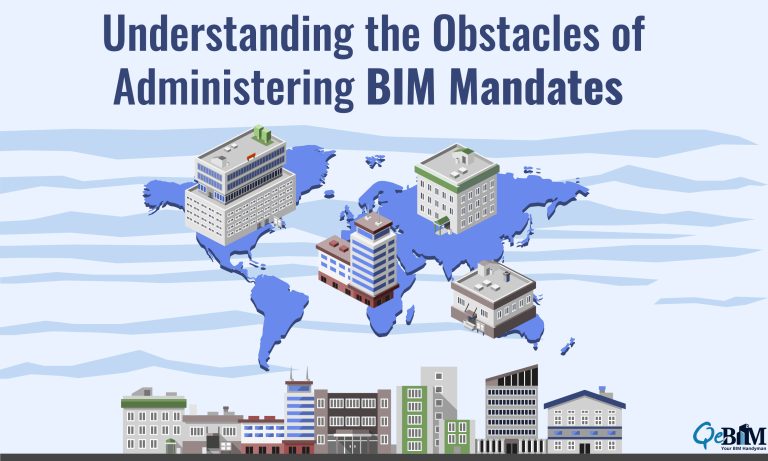Understanding the Obstacles of Administering BIM Mandates

Introduction
Building information modeling (BIM) represents a cutting-edge and team-based method for designing, constructing, and managing infrastructures. Construction businesses, building owners, and other parties associated with the building industry are required to use BIM under BIM mandates. BIM offers numerous advantages, yet putting BIM mandates into practice can be difficult. We’ll talk about the difficulties in implementing BIM mandates in this article on the blog along with how to fix them.
1) Lack of BIM expertise and knowledge
The absence of understanding and expertise in BIM is the primary obstacle to BIM-mandated execution. Most industry workers might not be accustomed to BIM or have a working knowledge of its tools and software. In order to improve the understanding and skills of building professionals in BIM, it is of the utmost importance to offer them training and education.
Solution: Offering BIM Education and Training
Organizations might assist their employees by offering BIM education and training to get around this obstacle. Workshops, webinars, and training courses might be used for this. Construction industry employees can participate in BIM accreditation programs to advance their BIM expertise.
2) Limited Access to BIM Software
The restricted accessibility of BIM software is an additional challenge in implementing BIM standards. BIM software is widely accessible, yet certain organizations may not possess the funds to buy or license it. This might prevent the widespread implementation of BIM.
Solution: BIM software that is freely accessible
Organizations may want to think about employing open-sourced BIM software to get around this issue. Everyone is able to acquire and utilize open-source software for free. Software for BIM that is open-source includes FreeCAD, BIMserver, and BlenderBIM.
3) Compatibility Issues using Current Systems
The conflicting requirements of BIM with present technologies is the third issue with BIM-mandated implementation. Technologies for project management, accounting, and numerous other procedures are already in place in many organizations. The widespread implementation of BIM could get difficult since certain systems might not be BIM-compatible.
Solution: BIM integration with current systems
Organizations can combine BIM using their present procedures to address this problem. The usage of APIs (Application Programming Interfaces), which enable data flow among BIM software and various other systems, might be used to accomplish this. Integration of BIM with present systems might enhance project management, increase cooperation, and decrease inaccuracies.
4) Intolerance of Change
Resistance to alteration constitutes the fourth difficulty in implementing BIM regulations. Certain stakeholders could be averse to adapting and favor sticking with conventional construction techniques. This might render it difficult to embrace BIM.
Solution: Change management
Organizations can use change management techniques to address this issue. In order to effectively oversee change, it is necessary to determine the stakeholders that are opposed to it and solve their issues. Such might be accomplished by interaction with the implementation of the BIM process, communication, and education.
5) Implementation Cost
The cost of implementation is the fifth obstacle to BIM-mandated deployment. Software, hardware, and training investments are necessary for the implementation of BIM. SMEs, or small and medium-sized enterprises, may encounter difficulties as a result.
Solution: Cost-benefit assessment
Organizations can perform an evaluation of costs and benefits to address this issue. The expenses and benefits of adopting BIM are to be determined through a cost-benefit analysis. The advantages of using BIM Service Providers might involve better management of projects, decreased inaccuracies, and enhanced collaboration. Organizations may utilize a cost-benefit evaluation to assess whether adopting BIM will result in more advantages than expenses.
6) Contractual and Legal Issues
Legal and contractual difficulties are the sixth difficulty in implementing BIM mandates. Adoption of BIM necessitates modifications to contract language including obligation distribution. Contractual as well as legal concerns which require to be resolved may result from this.
Solution: Standardisation and collaboration
Organizations might collaborate alongside stakeholders in the industry to create standardized contract language and liability allocation which encourages the adoption of BIM to get around this problem. Industry organizations may also contribute to the creation of BIM adoption standards and guidelines.
Conclusion
BIM Services requirements have become more prevalent in the building sector. Implementing Building Information Modelling (BIM) has many advantages, yet putting BIM mandates into practice might prove difficult. These difficulties include an absence of BIM knowledge and experience, a lack of BIM software options, issues related to compatibility with current systems, opposition to modification, installation expenses, and legal and contractual concerns. Organizations can address these issues by offering BIM instruction and instruction, taking into account open-source BIM software, integrating BIM with current systems, employing change management techniques, performing a cost-benefit assessment, and collaborating alongside industry stakeholders to create typical contract language and liability allocation to promote BIM adoption. Organizations can effectively carry out the requirements of BIM and benefit from BIM adoption through the proper methods.